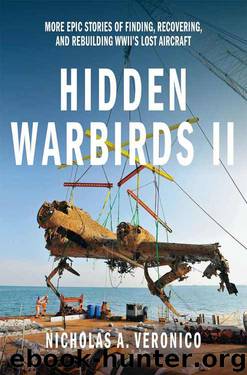Hidden Warbirds II: More Epic Stories of Finding, Recovering, and Rebuilding WWII's Lost Aircraft by Nicholas A. Veronico

Author:Nicholas A. Veronico [Veronico, Nicholas A.]
Language: eng
Format: epub
Publisher: Zenith Press
Published: 2014-06-14T21:00:00+00:00
A Sikorsky S-92 from Construction Helicopters lifted the center section of the Sandbar Mitchell and transported it to the airport at Fort Wainwright. The lift and flight took a little more than five minutes. Courtesy Warbirds of Glory Museum
The remaining part of the lower, aft fuselage had been buried in silt as well. That section was dug out and removed by hand. It was nearly the entire rear fuselage floor including the door and boarding ladder.
On the third day, June 25, the team broke into groups, working on the inboard flaps, the aft nacelle sections, and the landing gear doors. Then the remains of the forward and aft fuselage sections were carefully unbolted. Another group worked on removing hydraulic lines and the control cables, while Mihalek worked in the bomb bay under the aft fuselage removing the aileron bell crank and the emergency flap extension gearbox. Next task was to remove all of the hardware around the attach angles of the fuselage.
The fourth day saw the forward and aft fuselage removed from the center section. The flat-bottom riverboat took all of the parts, including the 650 pounds of borate tank scrap, back to Fairbanks. It could haul 2,500 pounds per trip, and they kept the boat busy all day.
On the day of the actual anniversary, June 27, nearly everything was off the island except the center section and the remaining part of the nose section. The team spent most of that day cleaning up the area and digging under the silt for any remaining pieces.
During the recovery effort, they took a piece of the borate tank aluminum back to Fairbanks and flattened it. The team had brought a plaque that had been made back in Michigan and attached it to the piece from the tank, which was then mounted on a piece of well drilling pipe. The plaque was installed and dedicated on June 27 at 2:30 p.m., forty-four years to the minute after the crash. The plaque tells the story of the plane and honors Thorsrud and Gallaher for their careers as aerial fire fighters. After the ceremony, the team went to downtown Fairbanks where the local Experimental Aircraft Association chapter held a banquet and party in their honor.
The following day it was all hands on deck to get the nose section moved from the crash site to the boat. The nose section weighed about a thousand pounds, and it took the entire crew to carry it about a hundred feet at a time, set it down, then carry it again. With the nose section off the sandbar, all that was left was the center section.
The majority of the team departed Fairbanks on July 2, leaving Mihalek, Trainor and his wife, Anna, and Fairbanks locals Fred Aker and Phil Schad. On July 4, the trucking cradle was built for the center section.
On July 5, the helicopter came and in a total of ten minutes the operation was complete. “It flew over, I rigged it, and attached it to the helicopter,” Mihalek said.
Download
This site does not store any files on its server. We only index and link to content provided by other sites. Please contact the content providers to delete copyright contents if any and email us, we'll remove relevant links or contents immediately.
| Africa | Americas |
| Arctic & Antarctica | Asia |
| Australia & Oceania | Europe |
| Middle East | Russia |
| United States | World |
| Ancient Civilizations | Military |
| Historical Study & Educational Resources |
Before Topgun Days: The Making of a Jet Fighter Instructor by Dave Baranek(793)
Enemy Coast Ahead by Guy Gibson(685)
The SAS Training Manual by Chris McNab;(673)
The True Story of Catch 22 by Patricia Chapman Meder(586)
Comet! The World’s First Jet Airliner by Graham Simons(581)
Outlaws Inc. by Matt Potter(563)
Airborne by Tom Clancy(526)
The Other Side of Airfix by Authur Ward(524)
The Wright Company by Edward J. Roach(522)
Memoirs of a Stuka Pilot by Helmut Mahlke(508)
Beyond Band of Brothers by Richard D. Winters(498)
Hitler's Eagles by Chris McNab(494)
Air Warriors by Douglas Waller(463)
Boyd by Robert Coram(457)
Stormchasers by David Toomey(448)
Pegasus, The Heart of the Harrier: The History and Development of the World's First Operational Vertical Take-off and Landing Jet Engine by Andrew Dow(448)
Airborne (1997) by Clancy Tom(444)
Focke-Wulf Fw 190 by CHRIS GOSS(422)
I Always Wanted to Fly by Wolfgang W. E. Samuel(409)
